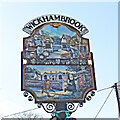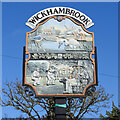1
Houses on Bunters Road, Wickhambrook
Image: © David Howard
Taken: 26 Sep 2023
0.16 miles
2
United Reformed Church, Wickhambrook
The Meeting House, or Chapel, is known as the ‘bottom chapel’ because it is at the lower end of Cemetery Hill, at Meeting Green (which was formerly Meeting House Green).
Image: © Bob Jones
Taken: 22 Jun 2006
0.19 miles
3
Wickhambrook War Memorial
The Memorial is in the cemetery a short distance from the Memorial Hall.
The Memorial bears 20 names of men killed in WW1 and 6 lost in WW2.
Image: © Adrian S Pye
Taken: 27 Apr 2015
0.19 miles
4
Strolling down Cemetery Road, Wickhambrook
Image: © Adrian S Pye
Taken: 27 Apr 2015
0.21 miles
5
The Memorial Hall, Wickhambrook
Built just after WW2 as a memorial to the six men who never returned.
Image: © Adrian S Pye
Taken: 27 Apr 2015
0.21 miles
6
Wickhambrook village sign (north face)
On this side the crown at the top represents the visit of Princess Anne to the village in 1979. The upper panel shows two of the village crafts, bakery and thatching, and the two pubs, The Greyhound and The Cloak, in the background, the latter having closed in 1989 The tree between them represents the orchards of Justin Brooke of Clopton Hall.
The lower panel depicts the Victorian school with the children playing. The post box, dating from 1859 and the only one of its kind in the British Isles. The south face can be seen here https://www.geograph.org.uk/photo/6790517
https://www.geograph.org.uk/photo/4295586
Thanks to Peter Miller and Wickhambrook website
Image: © Adrian S Pye
Taken: 29 Mar 2021
0.22 miles
7
Wickhambrook village sign (south face)
At the top of the sign just below the name is a comedy and tragedy mask probably representing pantomime and the parish carnival held annually. The scene above the centre depicts All Saints church, the old post-mill known as Bullock's Mill which was built at Thorns corner about 1830, and demolished about 1914. The thatched cottage is one of many in the village. The bridge over the River Glem has been modernised and kingfishers and herons are infrequent visitors. The farmer in the field stooking-up sheaves represents the arable farms in the parish. The bar between the panels depicts the leaves and fruit of the trees common to the village with, at its centre, a likeness of a carving of a man with spear and shield which can be seen at the church. On the bottom panel, the house in the background represents the manor houses of the village, the playing field and our eleven village greens; Cricket in the village dates back to the 1800s. The spectator with the dog, and wearing a stovepipe hat has handcuffs draped over his arm, the village peeler or beadle no doubt. The north face can be seen here https://www.geograph.org.uk/photo/6790512
https://www.geograph.org.uk/photo/4295586
Thanks to Peter Miller and Wickhambrook website
Image: © Adrian S Pye
Taken: 29 Mar 2021
0.22 miles
8
Wickhambrook village sign
At the top of the sign just below the name is a comedy and tragedy mask probably representing pantomime and the parish carnival held annually. The scene above the centre depicts All Saints church, the old post-mill known as Bullock's Mill which was built at Thorns corner about 1830, and demolished about 1914. The thatched cottage is one of many in the village. The bridge over the River Glem has been modernised and kingfishers and herons are infrequent visitors. The farmer in the field stooking-up sheaves represents the arable farms in the parish. The bar between the panels depicts the leaves and fruit of the trees common to the village with, at its centre, a likeness of a carving of a man with spear and shield which can be seen at the church. On the bottom panel, the house in the background represents the manor houses of the village, the playing field and our eleven village greens; Cricket in the village dates back to the 1800s. The spectator with the dog, and wearing a stovepipe hat has handcuffs draped over his arm, the village peeler or beadle no doubt.
On the other side (b) the crown at the top represents the visit of Princess Anne to the village in 1979. The upper panel shows two of the village crafts, bakery and thatching, and the two pubs, The Greyhound and The Cloak, in the background, the latter having closed in 1989 The tree between them represents the orchards of Justin Brooke of Clopton Hall.
The lower panel depicts the Victorian school with the children playing. The post box, dating from 1859 and the only one of its kind in the British Isles.
Close ups of each side https://www.geograph.org.uk/photo/6790512 https://www.geograph.org.uk/photo/6790517
Thanks to Peter Miller and Wickhambrook website.
Image: © Adrian S Pye
Taken: 17 Aug 2007
0.22 miles
9
House at the crossroads
A sunny house on a sunny day.
Image: © Robin Webster
Taken: 8 Apr 2017
0.22 miles
10
The village sign at Wickhambrook
The sign stands in Cemetery Road.
Image: © Robert Edwards
Taken: 10 Jul 2009
0.24 miles











